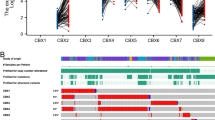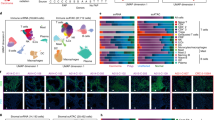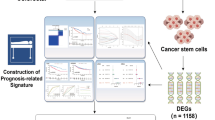Abstract
Chromobox homolog 2 (CBX2), a component of the polycomb repressive complex 1, is overexpressed in various cancers, but its specific role in colorectal cancer (CRC) is not fully understood. This study aimed to characterize the functional and regulatory roles of CBX2 in CRC. Tissue microarray analysis revealed the elevated CBX2 levels in tumor compared to adjacent normal tissues, which is significantly correlated with poor prognosis. Gain and loss of function studies demonstrated that CBX2 significantly promoted CRC progression and chemoresistance in cell lines, patient-derived CRC organoids and xenografts. In the AOM/DSS mouse model, treatment with the innovatively-developed cy5-PBAE/siCBX2 nanoparticle significantly reduced tumor aggressiveness. Mechanistic studies unveiled that the transcription factor RUNX1 is the positive regulator of CBX2. RNA-seq, ATAC-seq and CUT & RUN results indicated CBX2 knockdown induced epigenetic changes, especially alterations in chromatin accessibility. Moreover, we further identified MAP4K1 as a target gene of RUNX1-CBX2, with significant clinical and prognostic relevance in CRC. Collectively, these findings suggest the pivotal role of RUNX1-CBX2-MAP4K1 axis in CRC progression and underscore CBX2 as a promising biomarker and therapeutic target.

The regulatory function of CBX2 on chromatin accessibility and the role of the RUNX1-CBX2-MAP4K1-pERK axis in the progression of colorectal cancer.
This is a preview of subscription content, access via your institution
Access options
Subscribe to this journal
Receive 50 print issues and online access
269,00 € per year
only 5,38 € per issue
Buy this article
- Purchase on SpringerLink
- Instant access to full article PDF
Prices may be subject to local taxes which are calculated during checkout








Similar content being viewed by others
Data availability
All data associated with this study were present in the paper or the additional files. All datasets or information generated in this study are available upon reasonable request from the corresponding authors. The sequencing datasets have been deposited in the Gene Expression Omnibus (GEO) database as GSE284547.
References
Bray F, Laversanne M, Sung H, Ferlay J, Siegel RL, Soerjomataram I, et al. Global cancer statistics 2022: GLOBOCAN estimates of incidence and mortality worldwide for 36 cancers in 185 countries. CA Cancer J Clin. 2024;74:229–63.
Melina A, Christian CA, Rachel EN, Jerome V, Edward LG, Katherine AM, et al. Global burden of 5 major types of gastrointestinal cancer. Gastroenterology. 2020;159:335–49.e15.
Gholamreza R, Fatemeh G-K, Reza M. Colorectal cancer: epidemiology, risk factors, and prevention. Cancers. 2024;16:1530.
Junyi X, Dongying G, Shuwei L, Sangni Q, Yifei C, Wei S, et al. Integration of pathologic characteristics, genetic risk and lifestyle exposure for colorectal cancer survival assessment. Nat Commun. 2024;15:3042.
Ree AH, Šaltytė Benth J, Hamre HM, Kersten C, Hofsli E, Guren MG, et al. First-line oxaliplatin-based chemotherapy and nivolumab for metastatic microsatellite-stable colorectal cancer-the randomised METIMMOX trial. Br J Cancer. 2024;130:1921–8.
Marwan F, Chongkai W, Jaideep S, Jian Y, Colt E, Xiaochen L. Immunotherapy response in microsatellite stable metastatic colorectal cancer is influenced by site of metastases. Eur J Cancer. 2023;196:113437.
Rona Y, Nataliya VU, Meredith SP, Tanios SB-S, Minal B, Joel S, et al. Efficacy and safety of adagrasib plus cetuximab in patients with KRASG12C-mutated metastatic colorectal cancer. Cancer Discov. 2024;14:982–93.
Lindsay WB, Donald SB, Vu TN, Philip R, Tomomi MY, Elizabeth RW, et al. Novel chromobox 2 inhibitory peptide decreases tumor progression. Expert Opin Ther Targets. 2023;27:361–71.
Nunzio DG, Antonella DC, Ning Qing L, Lidio C, Carmela DA, Guglielmo B, et al. CBX2 shapes chromatin accessibility promoting AML via p38 MAPK signaling pathway. Mol Cancer. 2022;21:125.
Glancy E, Wang C, Tuck E, Healy E, Amato S, Neikes HK, et al. PRC2.1- and PRC2.2-specific accessory proteins drive recruitment of different forms of canonical PRC1. Mol Cell. 2023;83:1393–411.e7.
Susan LK, Matthew MM, Baymaz HI, Lisa VV, Ino DK, Alexandra S, et al. The dynamic interactome and genomic targets of Polycomb complexes during stem-cell differentiation. Nat Struct Mol Biol. 2016;23:682–90.
Wunderlich Z, Bragdon MDJ, Vincent BJ, White JA, Estrada J, DePace AH. Non-canonical PRC1.1 targets active genes independent of H3K27me3 and is essential for leukemogenesis. Cell Rep. 2016;14:3030.
Anke S, Maarten VL. Polycomb silencers control cell fate, development and cancer. Nat Rev Cancer. 2006;6:846–56.
He Z, Yongfu X, Zuoliang L, Songlin H, Tong Z. Expression and prognostic significance of CBX2 in colorectal cancer: database mining for CBX family members in malignancies and vitro analyses. Cancer Cell Int. 2021;21:449.
Rui S, Xucan T, Shixin C, Xu W, Yizhong J, Zhenglin W, et al. CBX2 deletion suppresses growth and metastasis of colorectal cancer by Mettl3-p38/ERK MAPK signalling pathway. J Cancer. 2024;15:2123–36.
Deli H, Andrew JF, Jonathan AG, Coralee ET, Joseph RB, Kirsten MT, et al. RUNX1-dependent mechanisms in biological control and dysregulation in cancer. J Cell Physiol. 2018;234:8597–609.
Guo X, Zhang H, He C, Qin K, Lai Q, Fang Y, et al. RUNX1 promotes angiogenesis in colorectal cancer by regulating the crosstalk between tumor cells and tumor associated macrophages. Biomark Res. 2024;12:29.
Planagumà J, Díaz-Fuertes M, Gil-Moreno A, Abal M, Monge M, García A, et al. A differential gene expression profile reveals overexpression of RUNX1/AML1 in invasive endometrioid carcinoma. Cancer Res. 2004;64:8846–53.
Lina T, Yunling G, Yongqi S, Yang L, Yanshu L, Hongyan Z, et al. PAK4 phosphorylating RUNX1 promotes ERα-positive breast cancer-induced osteolytic bone destruction. Int J Biol Sci. 2020;16:2235–47.
Nicholas R, Susan MM, Laura M, Henry JMD, Kirsteen JC, Ann H, et al. RUNX1 is a driver of renal cell carcinoma correlating with clinical outcome. Cancer Res. 2020;80:2325–39.
Philip Chiu-Tsun T, Max Kam-Kwan C, Jeff Yat-Fai C, Alex Siu-Wing C, Dongmei Z, Chunjie L, et al. Hematopoietic transcription factor RUNX1 is essential for promoting macrophage-myofibroblast transition in non-small-cell lung carcinoma. Adv Sci. 2023;11:e2302203.
Qingyuan L, Qiuhua L, Chengcheng H, Yuxin F, Qun Y, Yue Z, et al. RUNX1 promotes tumour metastasis by activating the Wnt/β-catenin signalling pathway and EMT in colorectal cancer. J Exp Clin Cancer Res. 2019;38:334.
Qingyuan L, Qiuhua L, Chengcheng H, Haonan Z, Xingzhu P, Haolin L, et al. RUNX1 regulates the proliferation and chemoresistance of colorectal cancer through the Hedgehog signaling pathway. J Cancer. 2021;12:6363–71.
Nadin HS, Dana MZ, Nour NAJ, Salma HM, Hussein HI, Hany AO. The interplay of p38 MAPK signaling and mitochondrial metabolism, a dynamic target in cancer and pathological contexts. Biochem Pharmacol. 2024;225:116307.
Yaping Y, Tengkun D, Mengmeng G, Xu Z, Chao C, Ya Z, et al. A review of non-classical MAPK family member, MAPK4: a pivotal player in cancer development and therapeutic intervention. Int J Biol Macromol. 2024;271:132686.
Sanz-Garcia E, Argiles G, Elez E, Tabernero J. BRAF mutant colorectal cancer: prognosis, treatment, and new perspectives. Ann Oncol. 2017;28:2648–57.
Daniel WP, Allan SH, Suzie P, Patrick SS. Design and development of polymers for gene delivery. Nat Rev Drug Discov. 2005;4:1026.
Antonella M, Stephany Yi T, Kristen Lynn K, Yuan W, Yike J, David G, et al. Polymeric nanoparticles for nonviral gene therapy extend brain tumor survival in vivo. ACS Nano. 2015;9:1236–49.
Lingmin Z, Sai D, Yanfen Z, Qingsheng P, Huan L, Ping W, et al. Homotypic targeting delivery of siRNA with artificial cancer cells. Adv Healthc Mater. 2020;9:e1900772.
Zuoming X, Yinghong W, Meng Y, Huamei W, Jian P. CBX2-mediated suppression of SIAH2 triggers WNK1 accumulations to promote glycolysis in hepatocellular carcinoma. Exp Cell Res. 2023;426:113513.
Xing Y, Ba-Tu J, Dong C, Cao X, Li B, Jia X, et al. Phosphorylation of USP27X by GSK3β maintains the stability and oncogenic functions of CBX2. Cell Death Dis. 2023;14:782.
Lindsay JW, Zachary LW, Lubna Q, Tomomi MY, Miriam DP, Amber AB, et al. CBX2 identified as driver of anoikis escape and dissemination in high grade serous ovarian cancer. Oncogenesis. 2018;7:92.
Lucie JB, Chloe W, Rebecca MH, Shannon K, Ella W, Thomas F, et al. The epigenetic regulatory protein CBX2 promotes mTORC1 signalling and inhibits DREAM complex activity to drive breast cancer cell growth. Cancers. 2022;14:3491.
Zhao X, Li L, Yuan S, Zhang Q, Jiang X, Luo T. SPIB acts as a tumor suppressor by activating the NFkB and JNK signaling pathways through MAP4K1 in colorectal cancer cells. Cell Signal. 2021;88:110148.
Wang Q, Zhang Y, Yang H. Pdcd4 knockdown up-regulates MAP4K1 expression and activation of AP-1 dependent transcription through c-Myc. Biochim Biophys Acta. 2012;1823:1807–14.
Pack D, Hoffman A, Pun S, Stayton P. Design and development of polymers for gene delivery. Nat Rev Drug Discov. 2005;4:581–93.
Liu X, Li X, Zheng P, Yang W. DAX1 promotes cervical cancer cell growth and tumorigenicity through activation of Wnt/β-catenin pathway via GSK3β. Cell Death Dis. 2018;9:339.
Wang B, Zhang S, Wang H, Wang M, Tao Y, Ye M, et al. Identification of EGR4 as a prospective target for inhibiting tumor cell proliferation and a novel biomarker in colorectal cancer. Cancer Gene Ther. 2024;31:871–83.
Zhongguang L, Bangting W, Feifei L, Yumeng G, Ning J, Jinsong W, et al. Establishment of a large-scale patient-derived high-risk colorectal adenoma organoid biobank for high-throughput and high-content drug screening. BMC Med. 2023;21:336.
Acknowledgements
We thank Xiang Wang, Min Wang, and Lianzhen Yu for their kind assistance of collecting the clinical samples. We would like to thank the Core Facility of First Affiliated Hospital of Nanjing Medical University for providing laboratory instruments.
Funding
This work was supported by grants from the National Natural Science Foundation of China (82202828, 82104089 and 82000621), The Friendship Hospital of Ili Kazkh Autonomous Prefecture (yl2023ms05; yl2023ms and YJC2024A14) and Jiangsu Association for Science and Technology (BE2022704, BE2023779). Jiangsu Province Hospital Clinical Capacity Enhancement Project (JSPH-MB-2022-10).
Author information
Authors and Affiliations
Contributions
SZ, BW and CT designed the study; BW, SZ, HW, YG, CT and WG performed the experiments; BW, SZ and CT analyzed the data; LL and YW supervised the work; and BW, SZ, JW, YG, CT and WG wrote the manuscript. All authors read and approved the final manuscript.
Corresponding authors
Ethics declarations
Competing interests
The authors declare no competing interests.
Ethics approval and consent to participate
The human study was approved by the Ethical Committee of Medical Research, The First Affiliated Hospital with Nanjing Medical University, and informed consent was obtained from all participants (2018-SR-258). All animal experimental protocols were approved by the Ethical Committee of Medical Research, Nanjing Medical University (IACUC-2207042). No blinding was done to both human and animal studies. The sample sizes for animal studies are three to six for each independent experiments as described in the relevant figure legends.
Additional information
Publisher’s note Springer Nature remains neutral with regard to jurisdictional claims in published maps and institutional affiliations.
Supplementary information
Rights and permissions
Springer Nature or its licensor (e.g. a society or other partner) holds exclusive rights to this article under a publishing agreement with the author(s) or other rightsholder(s); author self-archiving of the accepted manuscript version of this article is solely governed by the terms of such publishing agreement and applicable law.
About this article
Cite this article
Wang, B., Zhang, S., Guo, Y. et al. CBX2 as a therapeutic target in colorectal cancer: insights into the altered chromatin accessibility via RUNX1-CBX2-MAP4K1 axis. Oncogene 44, 909–926 (2025). https://doi.org/10.1038/s41388-025-03331-1
Received:
Revised:
Accepted:
Published:
Issue Date:
DOI: https://doi.org/10.1038/s41388-025-03331-1



